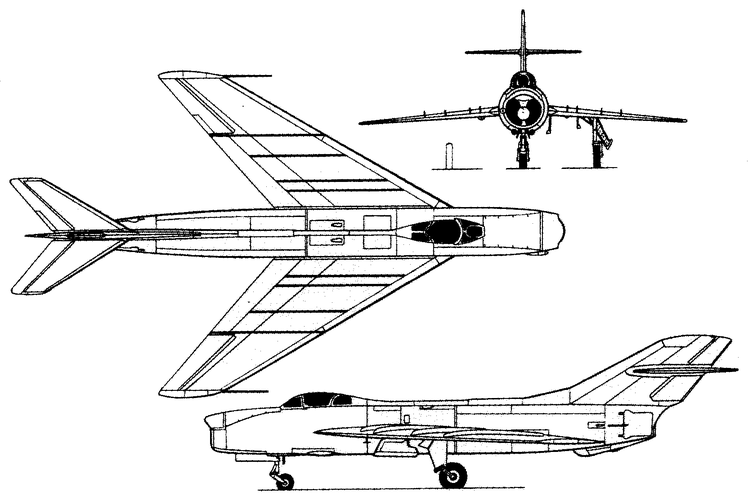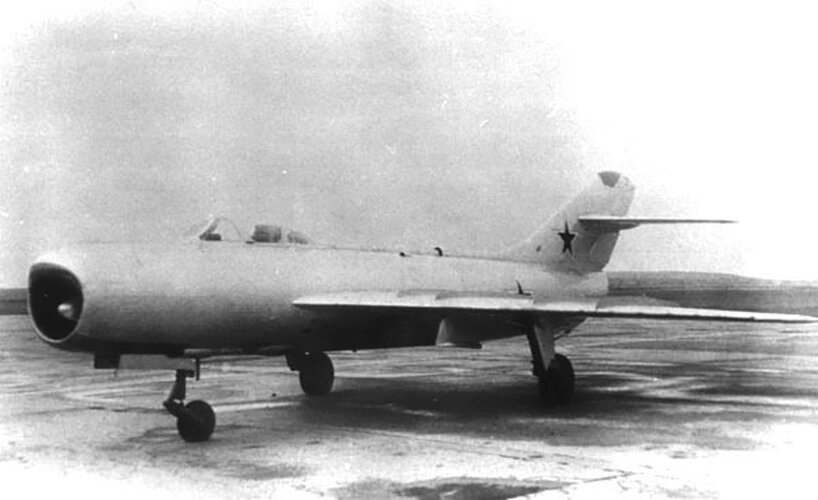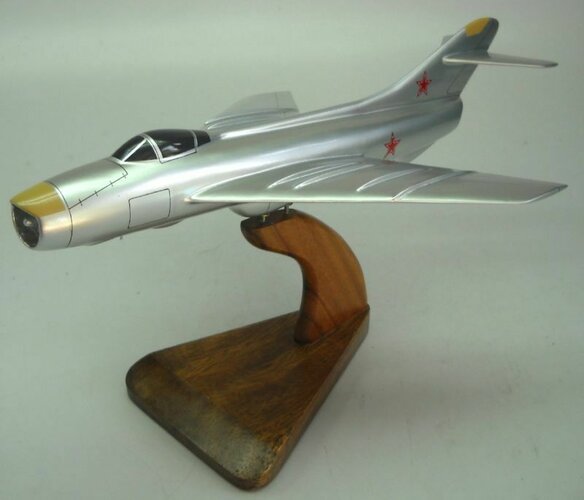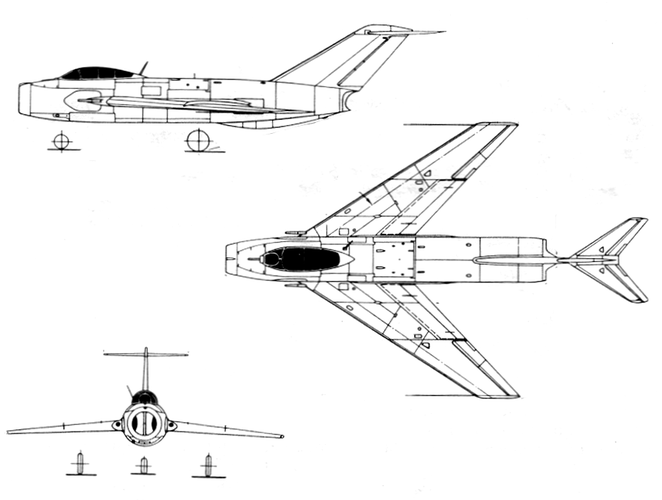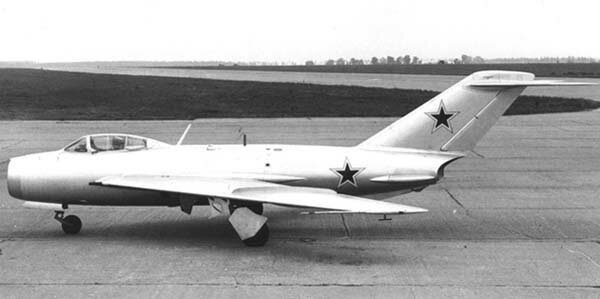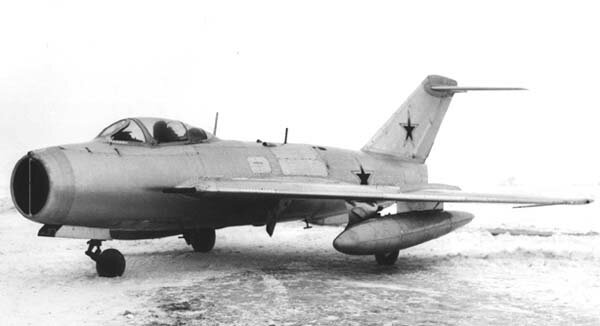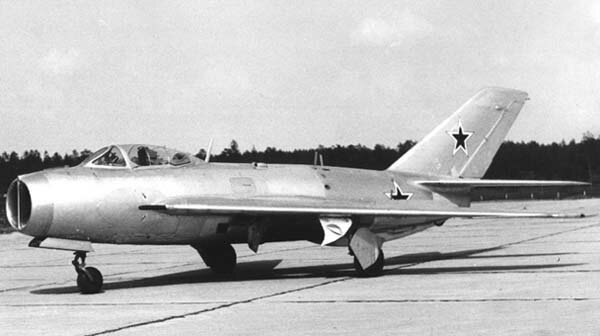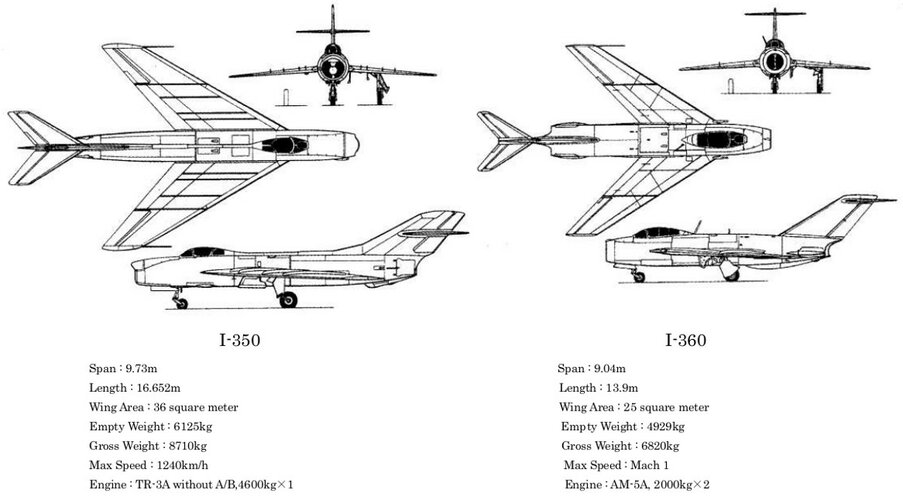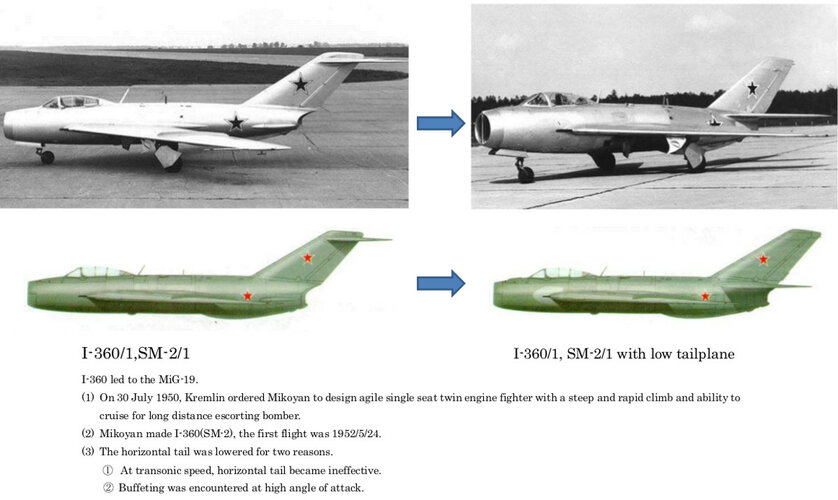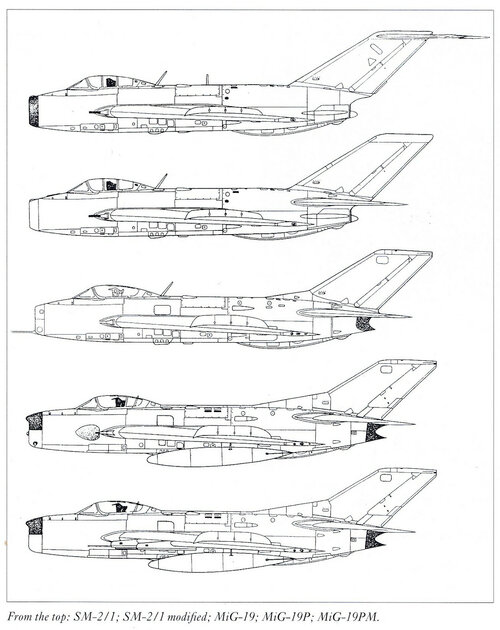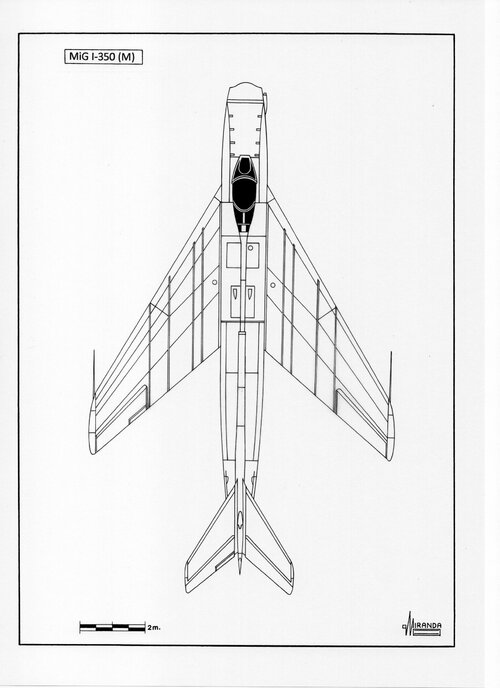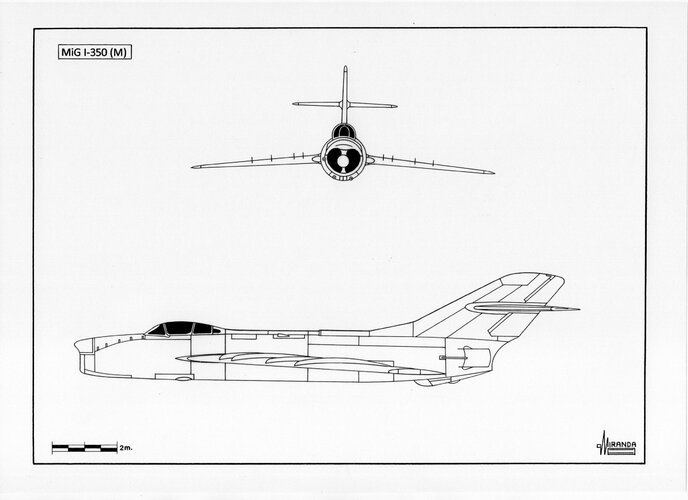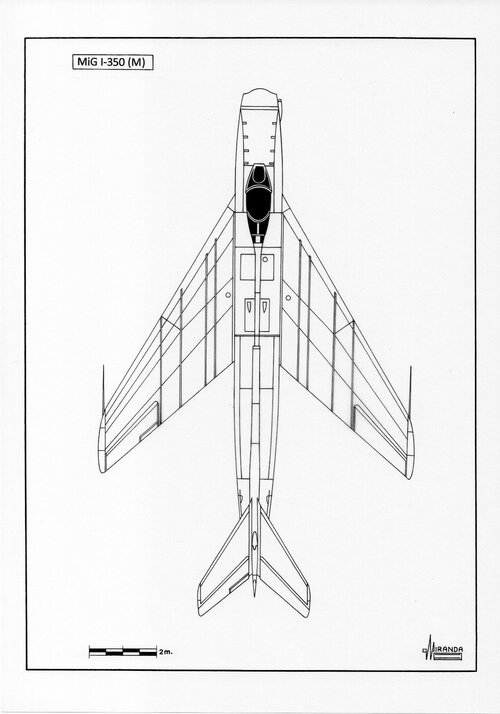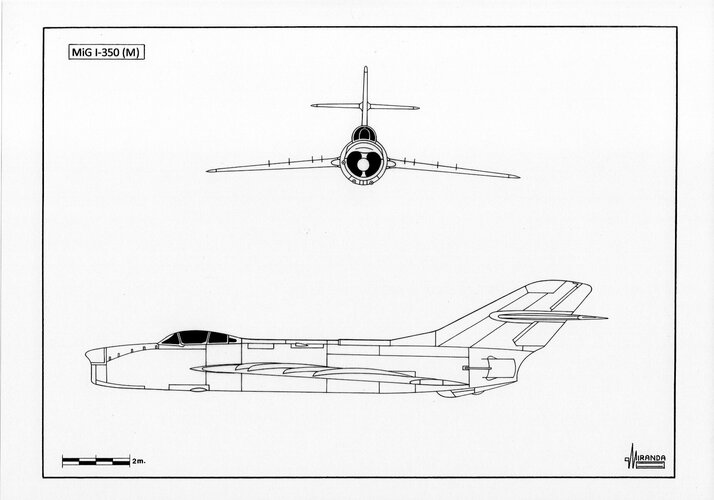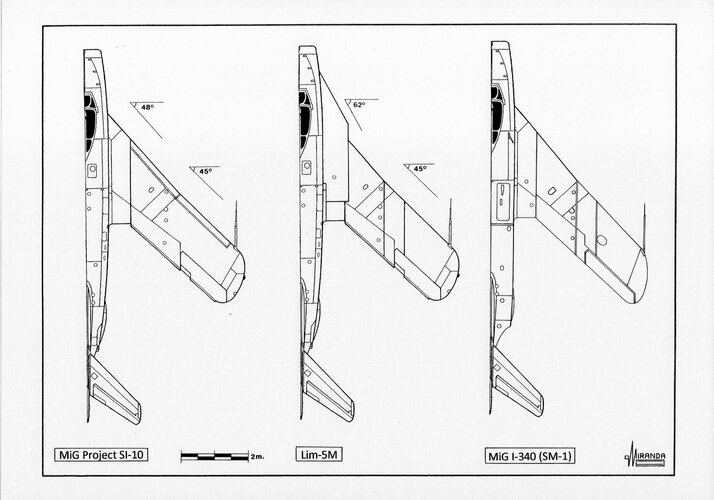Having overcome in 1948 on a MiG-15 (I-310, C) fighter the thousand-kilometer speed limit in OKB-155, headed by chief designer A.I. Mikoyan, together with TsAGI specialists, almost immediately outlined measures to further improve it. Already on July 26, 1949, a prototype of the MiG-17 (I-330, SI) fighter rises into the air, on which, in comparison with its predecessor, the sweep of the wing along the 1/4 chord line was increased from 35╟ to 45╟ to reduce the effect of air compressibility and also used thinner aerodynamic profiles. In connection with the installation of a new wing on the MiG-17, the tail section of the fuselage and the tail unit were also subjected to corresponding revision. These measures made it possible, with the same as that of the MiG-15bis (I-317, SD) VK-1 engine with a thrust of 2700 kgf, to increase the maximum speed from 1076 km / h to 1114 km / h.However, it was clear that more powerful propulsion systems were required to achieve even greater speeds. Further carried out by the OKB-45 team of the chief designer V.Ya. Klimov's work on forcing the VK-1 engine made it possible to raise its thrust to 3380 kgf. The subsequent installation of an engine, called VK-1F, on the MiG-17F (SF) aircraft made it possible, without changing its aerodynamics, to increase the maximum speed of the fighter to 1145 km / h.It is necessary to pay attention to the fact that the use of a forced VK-1F engine instead of VK-1 was accompanied by a slight increase in maximum speed. If the thrust of the VK-1 in comparison with the RD-45F increased by 19%, and the speed of the MiG-15bis in comparison with the MiG-15 increased by 2.8%, then with an increase in the thrust of the VK-1F by another 25%, the speed of the MiG-17F in compared to the MiG-17, it has grown by the same 2.8%. This is due to the fact that even when the afterburner was turned on, the MiG-17F fighter in horizontal flight did not reach supersonic speeds. On state tests of an experimental aircraft, conducted at the Air Force Research Institute of the Air Force in 1953, the maximum number of M was reached equal to 0.998, which was determined by recalculating the data obtained and bringing them to the conditions of a standard atmosphere.
A more significant increase in maximum speed when using afterburner is obtained only when the aircraft reaches supersonic speed. In this case, with an increase in the number M, there is no intensive increase in the coefficient of profile and harmful resistance, which leads to a rather significant increase in the maximum speed. The aerodynamic layout of the MiG-17 clearly did not meet the requirements of supersonic flight.
In this regard, back in July 1949, the OKB-155 team began to develop an experimental aircraft in order to achieve the speed of sound. By the end of the year, the preliminary design of the new machine was brought to 70% readiness.
Meanwhile, in addition to OKB-45 V.Ya. Klimov, work on the creation of promising jet engines was also carried out by OKB-165 and OKB-300 teams, headed by AM Lyulka and A.A., respectively. Mikulin. In the early 1950s, OKB-155 developed three new fighters for the new jet engines TR-3A and AM-5 created by them.
The first of them, the front-line fighter I-350 , was built in accordance with the "Plan for experimental construction of aircraft for 1950-51", approved on June 10, 1950 by the Resolution of the Council of Ministers of the USSR and communicated to all co-executors by the order of the Ministry of Aviation Industry that followed on June 14. It was expected that the TR-3A engine installed on the aircraft with a thrust of 5200 kgf would provide it with a supersonic flight speed. In accordance with the assignment, the I-350 was supposed to have a maximum speed of 1200 ... 1300 km / h at an altitude of 5000 m, a practical ceiling of 16000 m, a flight range of 1100 km, and with outboard fuel tanks of 1500 km. The plane was supposed to gain altitude of 5000 m in 2 minutes. Armament was supposed either from one 37-mm and two 23-mm cannons or from three 23-mm cannons.
The front-line fighter was ordered to be built in two copies. Moreover, the first copy was to be equipped with the already existing Korshun radar station, and the second with the Izumrud station, the development of which at NII-17 was already coming to an end. In April 1951, the car was required to be presented for state tests. At the same time, the task for the development of an experimental aircraft was excluded from the experimental work plan of OKB-155, due to the fact that it was included in the plan for 1950-51. the I-350 fighter was similar in its flight data.
Meanwhile, design work on the creation of the I-350 in OKB-155 was launched back in August 1949, and the draft design of the new machine was ready by July of the next year. In June, the construction of a model of the aircraft and the manufacture of models for blowing in the TsAGI wind tunnels began, and in October, the construction of the first flight prototype and a machine for static tests.
The I-350 fighter, which received the factory code "M", differed in many respects from its predecessors, and mainly in its aerodynamic layout, capable of providing confident supersonic flight.
The aircraft had a thin wing with a sweep of 57╟ and an aspect ratio of 2.6. To prevent air flow along the wingspan, four aerodynamic ridges were installed on the upper surface of each console. In view of the small thickness of the wing, the semi-forks of the main landing gear were located outside after cleaning and they were closed with special fairings placed on the wheel flaps. To reduce the mileage after landing, the aircraft was equipped with a braking parachute.
According to calculations, the I-350 with a take-off weight of 8030 kg should have had a maximum speed of 1240 km / h at the ground, 1244 km / h at an altitude of 5000 m and 1266 km / h at an altitude of 10,000 m.Its practical ceiling was estimated at 16600 m. m the plane was supposed to gain in 1.1 minutes, and 10,000 m - in 2.65 minutes. The fuel supply, located in two fuselage and six wing fuel tanks, provided a flight range of 1117 km. The use of outboard tanks increased the range to 1620 km.
On the first copy of the new aircraft, it was initially assumed, as required by the task, to install the Korshun radar. However, by this time, NII-17 had completed the development of a more promising Izumrud station, a prototype of which was installed in the summer of 1950 on an experimental MiG-15Pbis (SP-5) interceptor fighter for flight tests. Therefore, if good results were obtained during the tests, the designers provided for the possibility of installing the Izumrud radar also on the first I-350, which was later done. In addition to the radar station, the aircraft's special equipment included the RSIU-3 VHF radio station, the Bariy-M state recognition system and the OSP-48 blind landing equipment.
The armament of the I-350 fighter consisted of one 37-mm N-37 cannon with 50 rounds of ammunition and two 23-mm Sh-3 cannons with a total ammunition of 290 rounds. All cannon armament with ammunition was placed on a descending carriage, by analogy with the MiG-15 and MiG-17 fighters. The overload was provided for the suspension under the wing of two bombs with a caliber of 50 to 250 kg or two six-barreled launchers PU-85 for firing turbojet shells TRS-85. The aircraft's armor included 16-mm armor plate, 8-mm armored backrest, 16-mm armored headrest and 105-mm bulletproof glass.
To ensure the pilot's performance in the entire altitude range, the fighter was equipped with a sealed ventilation-type cabin. Flights at high altitudes were provided by the KP-14 oxygen device with three two-liter oxygen cylinders. The means of rescue were similar to those used on the MiG-15bis and MiG-17 aircraft.
In accordance with the directive schedule for the design and construction of the "M" product, approved by A.I. Mikoyan on June 28, 1950, the first copy of the I-350 fighter was supposed to leave the assembly shop by January 1, 1951. However, the given timeframe turned out to be unrealistic. The design and production of working drawings were completed only by the end of the year, and the technical readiness of the first flight prototype and the machine for statistical tests was 62%.
The fact that it would not be possible to meet the originally set deadlines became clear already at the beginning of August. This was due to the fact that the design of the aircraft had to be constantly changed. In particular, the Korshun radar station was replaced by the Izumrud station and the number of fuel tanks in the wing was reduced from six to four. In addition, static tests showed that the strength of the fuselage in the area of frame No. 18 is 90% of the design load, and this required additional measures to strengthen the aircraft structure. Therefore, it was necessary to adjust the work plan, and on September 2, the chief designer approved a new directive schedule, according to which the first car was to arrive at the airfield on January 30, 1951. Along with the first flight prototype, OKB-155 planned to start manufacturing a second aircraft in pilot production, which received the factory code "M-2". Her trials were to begin in May next year. However, in this case, too, the deadlines had to be shifted and by the end of the year the technical readiness of the M-2 was only 22%. In accordance with the schedule approved on March 24, 1951, the second prototype was supposed to go for testing on June 16, but this period was also soon postponed to September.
While OKB-155 was working on the manufacture of the I-350 aircraft, the state 100-hour bench tests of the TR-3A No. engine were completed with satisfactory results. 3A-165-11, the act according to which was approved by the Decree of the Council of Ministers of the USSR on March 28, 1951. By the same Decree, the TR-3A engine was named AL-5.
Meanwhile, to eliminate the phenomenon of surging in takeoff mode at negative values of the ambient air temperature, revealed during state tests in December 1950, for the TR-3A No. 3A-165-13 in February 1951, a new two-row guide vane of the 7th compressor stage was installed. But during control tests, the engine had to be stopped, as a large explosion of flame began from the jet nozzle. When disassembling it, it turned out that all the blades of the 7th stage compressor wheel had broken due to significant vibrations that had taken place.
By the time of the approval of the state testing act, the engine No. 3A-165-15, where a number of measures were taken to eliminate the identified deficiencies. In addition, engine No. 3A-165-10, the blades of the 7th stage of the compressor, including six reinforced ones, were subjected to strain gauging. However, the tests of the AL-5 No. 3A-165-10 showed that the performed strengthening of the blades did not give a significant reduction in stresses from vibration loads compared to unreinforced ones.
In connection with the revealed circumstances, OKB-165 specialists had to look for new design solutions. To eliminate the identified drawback, they developed six different measures, of which the best results were shown by turning the end sections of the blades of the 7th compressor stage at 4e and 7e (two options) towards a decrease in the angle of attack. Tests on AL-5 No. 3A-165-15 showed that vibration stresses decreased from 6 ... 7 kg / mm² to 1.2 ... 1.5 kg / mm². But based on the results obtained, the chief designer of AM Cradle decided to equip the 7th stage disc of the compressor of the engine No. 3A-165-15 version of the blades with a change in the 4th angle of installation and submit it for 100-hour tests to evaluate measures aimed at eliminating previously identified defects.
In addition, the AL-5 No. 3A-165-08 after a similar revision in May 1951 was sent to LII MAP for testing at the Pe-8 No. 42310 for the purpose of determining the surging margin and strain gauging of the compressor blades. Two flights performed in early June showed that at altitudes of 8000 m and 10000 m there are no surge phenomena at maximum speed. However, at an altitude of 8000 m, in take-off modes of engine operation, the phenomena of self-oscillations of a blade with a maximum value of stresses of about 3 kg / mm² were recorded.
While OKB-165 was solving the problems of its engine, in the experimental production of OKB-155, after finalizing the keel, stabilizer and fuselage, carried out according to the results of statistical tests, on May 31, 1951, the assembly of the first copy of the I-350 was completed. And already on June 1, the car was transferred to the OKB-155 flight station at the LII for factory tests. In accordance with the approved program, in the course of their implementation, it was planned to perform 93 flights, including 13 flights to prepare the aircraft for the air parade dedicated to the Air Fleet Day.
Due to the fact that after strengthening the aircraft structure, statistical tests of the tail were carried out only up to 90% of the design load, after which they had to be stopped for technical reasons, TsAGI specialists gave the following restrictions for the first copy of the I-350:
- velocity head no more than 6200 kg / m2 (calculated 6600 kg / m2).
- the number M is not more than 1.1 (according to the calculation when diving Мв1.5, in horizontal flight М = 1.15).
It should be noted that the I-350 was powered by the AL-5 No. 3A-165-12, which, like AL-5 No. 3A-165-14 intended for La-190, was not accepted by the military representative of the ATK Air Force at plant No. 165 (OKB-165). The military representatives motivated the refusal to accept the engines by the fact that design changes had been made to these specimens in the form of installing an expanded turbine nozzle with a flow area of 1838.3 cm². Thus, they differed from the reference engine that passed the state 100-hour bench tests. And to accept engines with such an improvement without having to carry out long 100-hour reliability tests,
In this regard, the AL-5 No. 3A-165-12 was installed on the first prototype of the I-350 aircraft under the personal responsibility of the chief designer AM Lyulka, and at plant No. 165 began to prepare a new engine for OKB-155 - AL-5 No. 3A-165-20.
By the order of the Ministry of Aviation Industry of June 16, 1951, a brigade consisting of test pilot G.A. Sedov, leading engineer K.P. Kovalevsky, mechanic G.E. Pavlov and the minder M.A. Ryzhkov. On the same day, after the completion of the ground part of the tests and the elimination of the identified deficiencies, the first flight of the I-350 took place.
The plane behaved normally on takeoff. The climb 1800 ... 2000 m also passed without remarks. In flight, the speed was increased to 680 km / h on the instrument. However, in the 8th minute, when the engine was throttled at an altitude of 1800 m, it stopped. In this regard, test pilot G.A. Sedov had to land in an emergency vehicle in extreme conditions, since the failure of the power plant led to a malfunction of the hydraulic system, with all the ensuing consequences. But despite the current situation, the pilot managed to make a normal landing at the LII airfield. Fortunately, the emergency pneumatic system for the landing gear, flaps and brake parachute did not fail. Moreover, the chassis was released just a few seconds before landing.
It should be noted that the phenomenon of self-shutdown in flight of the AL-5 engine with a fuel pressure in front of the injectors of about 16 kg / cm² was also detected on the La-190 aircraft, which was undergoing factory flight tests at the airfield of the Air Force Research Institute of the Air Force.
In connection with the new circumstances for the continuation of flights, the chief designer of AM Lyulka set the following restrictions, which were required to be strictly observed during the operation of the AL-5:
- to reset the speed in flight from the maximum allowable to the minimum mode by smoothly moving the gas sector for at least 15 ... 17 seconds at altitudes up to 5000 m;
- the minimum allowable fuel pressure in front of the nozzles in flight must be at least 20 ... 22 kg / cm² up to an altitude of 10,000 m;
- when the aircraft descended for landing from an altitude of 300 ... 500 m, it was allowed to switch the engine to idle mode by smoothly moving the control lever.
Already on June 19, test pilot G.A. Sedov made the second flight to an altitude of 4000 m, observing the specified restrictions. The flight, which took 20 minutes, passed without comment, while the maximum speed was brought up to 750 km / h on the instrument. The next day G.A. Sedov, in a Pe-8 flying laboratory at an altitude of 4000 m and a speed of 300 km / h, checked the AL-5 operation with an instantaneous movement of the gas sector from 6600 rpm to 2500 rpm. In this case, the engine was running normally, and the minimum fuel pressure in front of the injectors was 12 kg / cm².
The analysis of the reasons for the self-shutdown of the AL-5 engine when flying at a speed of more than 500 km / h showed that the movement of the gas sector from maximum revolutions towards their decrease leads to a sharp depletion of the mixture (an increase in the excess air ratio) in the combustion chamber, exceeding the limit of stable combustion. In turn, a sharp depletion of the mixture in the combustion chamber occurred due to the regulator, which sought to reduce engine speed in accordance with the new position of the gas sector, by reducing the fuel supply. At the same time, the speed of the oncoming flow prevented the decrease in speed, the change in which depended on the time of the change in the flight speed. Since the regulator did not have a limiter for reducing the fuel pressure, it continued to reduce the fuel supply, moreover, to a greater extent than was necessary for the engine to operate at rpm, corresponding to the new position of the gas sector. And since the limit of stable combustion in the combustion chamber was not high enough, the combustion stopped even at a rather high fuel pressure (12 ... 14 kg / cm²), that is, with excess air ratios in the range of 30 ... 35.
Based on the analysis carried out, OKB-165 developed and submitted to the military representation an action plan to eliminate the phenomenon of self-shutdown of the AL-5 engine in flight, which provided for work in two directions:
- increasing the boundary of stable combustion in the combustion chamber when the mixture is depleted;
- introduction into the design of the speed controller of an element that limits the drop in fuel pressure in front of the nozzles in flight to the minimum permissible limit at which the depletion of the mixture does not go beyond the boundary of stable combustion.
Due to the problems that emerged in the operation of the power plant, it was necessary to move away from the implementation of the I-350 factory test program and concentrate all work on studying the operation of the engine. In addition, by the decision of the chief designer A.I. Mikoyan in the experimental production of OKB-155 from June 21, 1951, work on the manufacture of the second flight copy of the I-350 fighter was stopped until the completion of the AL-5 engine. By this time, the readiness of the units of the M-2 machine was 90%.
In accordance with the aforementioned plan, on June 22nd, engine No. 3A-165-15 with a new version of the combustion chamber burners. For burners, designated EB-3408, the design of the body and swirler was changed, which made it possible to change the velocity field in front of the burners and the amount of air in the igniter zone. Due to these changes, it was supposed to increase the combustion stability. Preliminary tests of the burner at CIAM showed that the boundary coefficient was equal to 90 against the previously existing value of 30 ... 35.
After the completion of 25-hour bench tests, AL-5 No. 3A-165-15 without disassembly was sent to LII for installation on Pe-8 No. 42310. In flight in the flying laboratory, the engine worked steadily at altitudes up to 9500 m with a fuel pressure in front of the nozzles of 7 ... 11 kg / cm². At altitudes up to 8000 m at a flight speed of up to 300 km / h on the instrument, with a sharp cleaning of the gas sector in 0.5 seconds from the maximum mode to a fuel pressure of 4.2 ... 4.9 kg / cm², the engine did not turn off by itself. In addition, on the last day of June, the No.3 А-165-03 engine with new burners, which were supposed to provide stable combustion in the combustion chamber at higher coefficient values than the burners of the No. 3A-165-15.
Meanwhile, the AL-5 No. 3A-165-20 with the first version of the combustion chamber burners, and on June 28 it was sent to OKB-155 for installation on the I-350 aircraft. Two days later, control tests with the same burners and the AL-5 No. 3A-165-16 intended for La-190, and on July 2 it was sent to OKB-301. As instructed by AM A cradle in order to increase the combustion stability on the working injectors of both engines after they have been sent from factory No. 165 also installed caps to cover the annular gap between the burner and the nozzle.
While the experimental production of OKB-155 was changing the engine on the I-350 fighter, at plant No. 165 and LII continued testing engines No. 3A-165-03 and No. 3A-165-15. Moreover, the latter was additionally equipped with a special valve in order to maintain the minimum fuel pressure in front of the nozzles in flight. In addition, for a comprehensive assessment of all the improvements aimed at eliminating the phenomenon of self-shutdown, OKB-165 began to prepare the AL-5 No. 3A-165-18 for long-term 100-hour bench tests.
On bench tests, engine No. 3A-165-03 with the second burner version worked well, and a new mixer with a large number of holes installed on it made it possible to reduce specific fuel consumption by 2%. In addition, tests carried out at CIAM showed that such a mixer also contributed to an increase in combustion stability. However, disassembling the engine revealed a shift in the high temperature zone closer to the burners, which led to burnout of the mixers. And this, in turn, required further refinement.
In order to refine the speed regulator in OKB-165, in addition to the minimum pressure valve mentioned above, which showed unsatisfactory results, two more valve options were developed: a drain valve and a retarder valve. But on tests, the latter also showed unsatisfactory results. In this regard, in order to increase the stability of the regulation of the fuel supply to the engines intended for the I-350 and La-190 aircraft, only drain valves were installed.
Unlike AL-5 No. 3A-165-03 engine No. 3A-165-15 is out of luck. July 16 Pe-8 No. 42310 crashed while landing due to a broken left tire. The plane skidded, and it drove off the runway onto soft ground, which led to a chassis failure. Upon hitting the ground, the car caught fire, and it was not possible to save it. As a result of the fire at the AL-5 engine, the communications were burnt and there were burnouts from the external influence of the flame, in connection with which it was sent to plant No. 165 for disassembly and fault detection.
After installing the AL-5 No. 3A-165-20 on the I-350 fighter, test pilot G.A. Sedov performed two more flights on it, on July 17 and 19. They showed that the OP8049-00 drain valve, providing the minimum specified fuel pressures in front of the nozzles, along with greater stability of combustion in the combustion chamber, made it possible to eliminate the AL-5 self-shutdown defect in flight. After that, a new drain valve was installed on the engine, which improved the control characteristics.
On August 1, 1951, after the completion of the fuel system refinement, test pilot G.A. Sedov lifted the car into the air for the fifth time. The flight took place at altitudes up to 5000 m, and the speed was increased to 580 km / h by the instrument. At the same time, it turned out that at an altitude of 5000 m, when collecting gas to idle, the minimum engine speed was 5300 rpm, and when cleaning and dispensing gas, the engine sluggishly reached the set speed. The same results were obtained on August 4 on the La-190 aircraft, the tests of which were transferred to the LII, when at an altitude of 7000 m at a speed of 650 km / h on the instrument, after the gas sector was switched to idle, the minimum speed was 5700 rpm.
The results of both flights confirmed that the drain valve and new burners ensured that the engine operated without shutdown when cleaning the gas sector. However, the introduction of a drain valve into the fuel system brought about new problems. First, with an increase in flight altitude over 5000 m, idle speed increased unnecessarily. Secondly, the throttle response time increased to 60 seconds, and the engine sluggishly reached the set rpm.
To eliminate new defects, the regulator retarder ratchet was developed and sent for bench testing. At the same time, engine No. 3A-165-03 continued work to improve the stability of combustion and ensure the stability of the regulation of the fuel supply in flight at the minimum allowable pressure. In particular, a new version of burners with a diaphragm, which was a two-row grid located between swirlers and nozzles, with a reduced cross-section of holes and without a gap between the burner and nozzles, was developed and in August 1951 passed bench tests. On tests at CIAM, such a burner showed a further improvement in combustion stability. In addition, engine No. 3A-165-08 passed tests, albeit unsatisfactorily, a new version of the mixer.
After the completion of bench tests, the ratchet of the speed regulator retarder and a new version of the burners were planned to be installed on AL-5 No.No. 3A-165-12 and ZA-165-14, designed for the I-350 and La-190 aircraft, respectively. The assembly of these engines at factory No. 165 were supposed to be completed by mid-August. The chief designer of AM Lyulka guaranteed that the AL-5 engines with the indicated improvements would provide flight at all altitudes up to speeds corresponding to M-1.3 and at a minimum fuel pressure of 10 kg / cm². After receiving satisfactory results in flight tests, the AL-5 engine in the new layout was planned to be presented for 100-hour bench tests, which were provided for under the state program.
Unfortunately, it was not possible to solve the newly appeared problems on the move. The ratchet of the speed regulator retarder was rejected during tests and during debugging at the stand due to a number of structural defects identified. In this regard, in order to limit the drop in fuel pressure when the gas sector is switched to idle, OKB-165, instead of a ratchet, developed a new system with a valve that was included in the hydraulic part of the retarder servomotor.
The new development was tested on a bench for testing regulators and on the engine. Since it showed satisfactory results, by August 20, on the basis of the existing valves, the first copy of the retarder valve was assembled, manufactured according to new drawings, after which the unit, which received the name "MM idle valve", was sent to bench tests.
In late August, AL-5 No.No. engines were delivered for control tests. 3A-165-12 and ZA-165-14, on which, in addition to the modified combustion chamber (new burners with a double diaphragm, nozzles shifted by 3 mm towards the turbine, improved cooling of the mixers), MG-1 valves were installed. If satisfactory results are obtained in flight tests of these engines on an I-350 or La-190 aircraft, a similarly modified AL-5 No. 3A-165-18 was planned to be put on long-term 100-hour bench tests.
However, by this time, due to the "raw" engine, interest in the I-350 was gone. Already shortly after the last flight, by the Decree of the Council of Ministers of the USSR of August 10, 1951, work on the I-350 aircraft was officially terminated in connection with the start of work on the creation of the I-360 (SM-2) escort fighter with two AM-5 engines developed by OKB- 300 chief designer A.A. Mikulin.
Naturally, the production of the second copy of the I-350, the technical readiness of which was 75%, was not renewed, and the two-seater version of the fighter remained only on paper. The I-350 test program was completed by only 12%, and the vehicle was in the air for a total of about 1.5 hours.
Meanwhile, OKB-165 continued work on fine-tuning the AL-5 engine. After the elimination of a number of revealed defects on the first day of September, control tests of AL-5 No. 3A-165-14 designed for the La-190 aircraft, and on September 7 - AL-5 No. 3A-165-12 intended for the I-350. However, due to the termination of testing of both fighters, engines from factory No. 165 were not sent to OKB-301 and OKB-155.
In connection with the current situation, the chief designer of AM Lyulka made an attempt to achieve, through the leadership of the MAP, a solution to the issue of testing in flight conditions on aircraft of the OKB A.S. Lavochkin or A.I. Mikoyan's AL-5 engine with the latest revision. At the same time, factory No. 23, the re-equipment of the Tu-4 No. 230113 to a new flying laboratory designed to test the AL-5 engine, work on which was planned to be completed only by October 10.
Also in mid-September, the Deputy Commander-in-Chief of the Air Force, Major General of the IAS M.T. Shishkin sent a letter to the Deputy Minister of the Aviation Industry P.V. Dementieva with a request for an urgent continuation of flight tests of the La-190 aircraft with the AL-5 No. 3A-165-14 and the beginning of flight tests of the AL-5 No. 3A-165-12 on an I-350 aircraft in order to check measures to eliminate previously identified defects.
In a reply sent on October 18 by Deputy Minister S.N. Shishkin, it was reported that in-flight testing of the measures proposed by the design bureau of the chief designer AM Lyulka to eliminate defects in the AL-5 engine will be continued on the Tu-4 aircraft, the re-equipment of which into a flying laboratory was completed at the OKB-23 of the chief designer V.M. Myasishchev.
As for the use of the I-350 aircraft, S.N. Shishkin reported that this requires a government decision, since work on this machine was removed from OKB-155 in connection with the receipt of a new assignment. The tests of the La-190 aircraft were also temporarily stopped due to the fact that the Lavochkin Design Bureau received a special task from the Government, which is urgent. In turn, the AL-5 engines were installed on the newly built high-speed bombers - "150", developed in OKB-1, chief designer B. Baade and IL-46, created in OKB-240, chief designer SV. Ilyushin.
Therefore, it was planned to test the operation of the AL-5 engine at high flight speeds during flight tests of the indicated bombers.
Thus, the first attempt to create a supersonic fighter in the design bureau of chief designer A.I. Mikoyan was not crowned with success, however, the same fate befell the SA Design Bureau. Lavochkin with the La-190 aircraft. And the AL-5 engine was never put into mass production due to constantly arising problems, mainly caused by its poor layout. However, the experience gained by OKB-165 specialists during its development and fine-tuning served as a necessary basis for the creation of a more advanced AL-7 engine, which was put into mass production and used on domestic aircraft.
Specs
Modification I-350
Wingspan, m 9.73
Length, m 16.27
Wing area, m2 36.00
Weight, kg
empty plane 6177
maximum takeoff 8030
fuel 1600
engine's type 1 TRD TR-3A
Thrust, kgf 1 x 5200
Maximum speed, km / h
by the ground 1240
on high 1266
Practical range, km
normal 1260
with PTB 1825
Rate of climb, m / s 4546
Practical ceiling, m 16600
Crew, people 1
Armament: one 37 mm N-37 cannon and two 23 mm Sh-3 cannons

